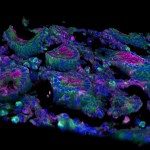Link to Pubmed [PMID] – 32712664
Link to DOI – ciaa104710.1093/cid/ciaa1047
Clin Infect Dis 2020 Jul; ():
Human genetic variation-mostly in the HLA and CCR5 regions-explains 25% of the variability in progression of HIV infection. However, it is also known that viral infections can modify cellular DNA methylation patterns. Therefore, changes in the methylation of CpG islands might modulate progression of HIV infection.85 samples were analyzed: 21 elite controllers (EC), 21 HIV-infected subjects before combination antiretroviral therapy (cART) (viremic, 93,325 HIV-1 RNA copies/ml) and under suppressive cART (cART, median of 17 months, <50 HIV-1 RNA copies/ml), and 22 HIV-negative donors (HIVneg). We analyzed the methylation pattern of 485,577 CpG in DNA from peripheral CD4+ T lymphocytes. We selected the most differentially methylated gene (TNF) and analyzed its specific methylation, mRNA expression, and plasma protein levels in 5 individuals before and after initiation of cART.We observed 129 methylated CpG sites (associated with 43 gene promoters) for which statistically significant differences were recorded in viremic vs HIVneg, 162 CpG sites (55 gene promoters) in viremic vs cART, 441 CpG sites (163 gene promoters) in viremic vs EC, but none in EC vs HIVneg. The TNF promoter region was hypermethylated in viremic vs HIVneg, cART, and EC. Moreover, we observed greater plasma levels of TNF in viremic individuals than in EC, cART, and HIVneg.Our study shows that genome methylation patterns vary depending on HIV infection status and progression profile and that these variations might have an impact on controlling HIV infection in the absence of cART.



